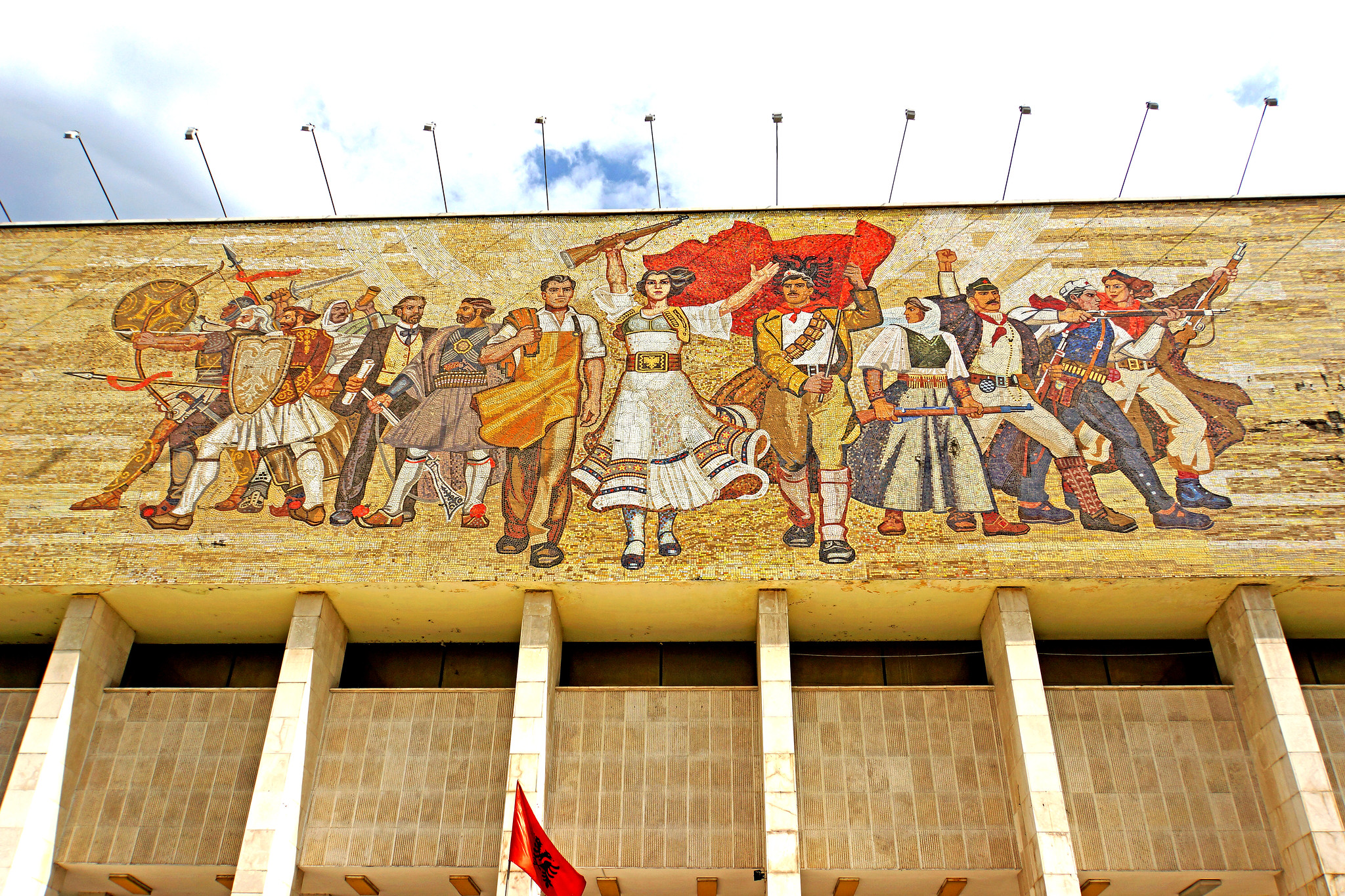Art and sex in communist Albania
Stalinist dogma called for socialist realist art that was meant to reproduce an enhanced (that is, unreal) reflection of the reality of “the people’s work and progress”. The stories of the pieces on display at a 2015 art exhibit in Tirana’s National Art Gallery demonstrate that socialist realist art was also quite prudish – but sometimes sexual, “anti-communist” art made it past the censors.
April 10, 2019 -
Tomasz Kamusella
-
Stories and ideas

"The Albanians", a mosaic from the communist era depicting the history of Albania. It forms the facade of the National History Museum in Tirana. Photo: Dennis Jarvis (cc) flickr.com
In late November 2015 I visited Albania and Kosovo with a series of lectures on ethnolinguistic nationalism. During one of the very few moments left by this intensive program I happened to visit the National Art Gallery in Tirana, Albania’s capital. The paintings and sculptures exhibited there are solely from the 20th century, the majority of them originating from the communist era. Socialist realism was art for politics’ sake as opposed to bourgeois (capitalist) art for art’s sake. That was the dogma of Stalinism in the field of fine arts. The system came to an end around 1956 across the Soviet bloc, but not in Albania, where Stalinism (with a hint of Maoism) ruled supreme until the fall of communism in this country in 1992.
Socialist (communist) art was meant to reproduce an enhanced – that is, unreal – reflection of the reality of “the people’s work and progress”. It was also quite prudish. No talk or images of the erotic (let alone of sex) were permitted in the public sphere. Janaq Paço (1914-1991) specialised in sculpting classical nudes, this being the canon of beauty in which the approved vision of the healthy muscular body of the socialist worker or peasant was steeped. Students of socialist realist art were to learn from the best examples of Greco-Roman classical art.
In 1964 the National Art Gallery in Tirana acquired one of Paço’s full-figure nudes. But a decade later, in 1974, the Sigurimi (communist Albania’s notorious security police) ordered the artist to destroy this nude, as well as others that he kept in his studio. The official reason of this sudden change of heart was that his sculptures were proof of unwanted foreign influence spreading and “infecting the wholesome body” of Albanian socialist realist art. Luckily, the destruction of the gallery’s nude below the waistline was deemed sufficient. The thusly created bust survived intact in the warehouse; as a dissident sculpture, it now rightfully takes a place of pride, for it is on display in the gallery’s exhibition on art from communist Albania.

Also featured in this exhibit is the art of the painter Petro Kokushta. Born in 1943, Kokushta never made the mistake of pandering to foreign bourgeois tastes. He stuck rigidly to officially prescribed themes and to the “correct way” in which they should be executed. Beyond the boredom of predictable communist visual propaganda, I was struck by the eerie beauty of one of Kokushta’s paintings, entitled “Reaching the Heights of Light” (1981). Ostensibly the two young workers depicted in the painting are installing some last pieces of machinery on a high voltage pylon that overlooks a deep valley. In the illusion created by this composition the two men, both in their prime, appear to be airborne, floating high above the earth, as free as angels in the dark deep blue of the sky. The background looks as though it were transported directly from an icon – and it was painted at a time when all mentions of religious symbols and ideas were taboo in communist Albania. After all, Albania was the world’s sole country where all religions (or the “opiate for the masses”, in Marxist jargon) were liquidated in 1967.

I wonder how it could be that censors and political officers failed to take note of this extraordinary counterrevolutionary challenge posed in the painting. And even more intriguing and blasphemous for communist Albania is the feeling that, out of earshot and only with each other in this austere environment, the two electricians seem a mere minute away from a tender embrace. The Islamic tradition of men being strictly separated from women yielded the custom of male friends holding hands and greeting with kisses on the cheeks. The suggestion of homoeroticism emanates unabashedly from this painting in direct defiance of the ideological decorum of communism. Was the painter aware of what he did? Luckily for him, unlike in the aforementioned case of Paço’s nudes, the party failed to notice the heavy hint of gay love in Kokushta’s masterpiece.
Tomasz Kamusella is a Reader in Modern Central and Eastern European History at the University of St Andrews in Scotland. His latest monograph Ethnic Cleansing during the Cold War: The Forgotten 1989 Expulsion of Turks from Communist Bulgaria was published by Routledge in July 2018.

































